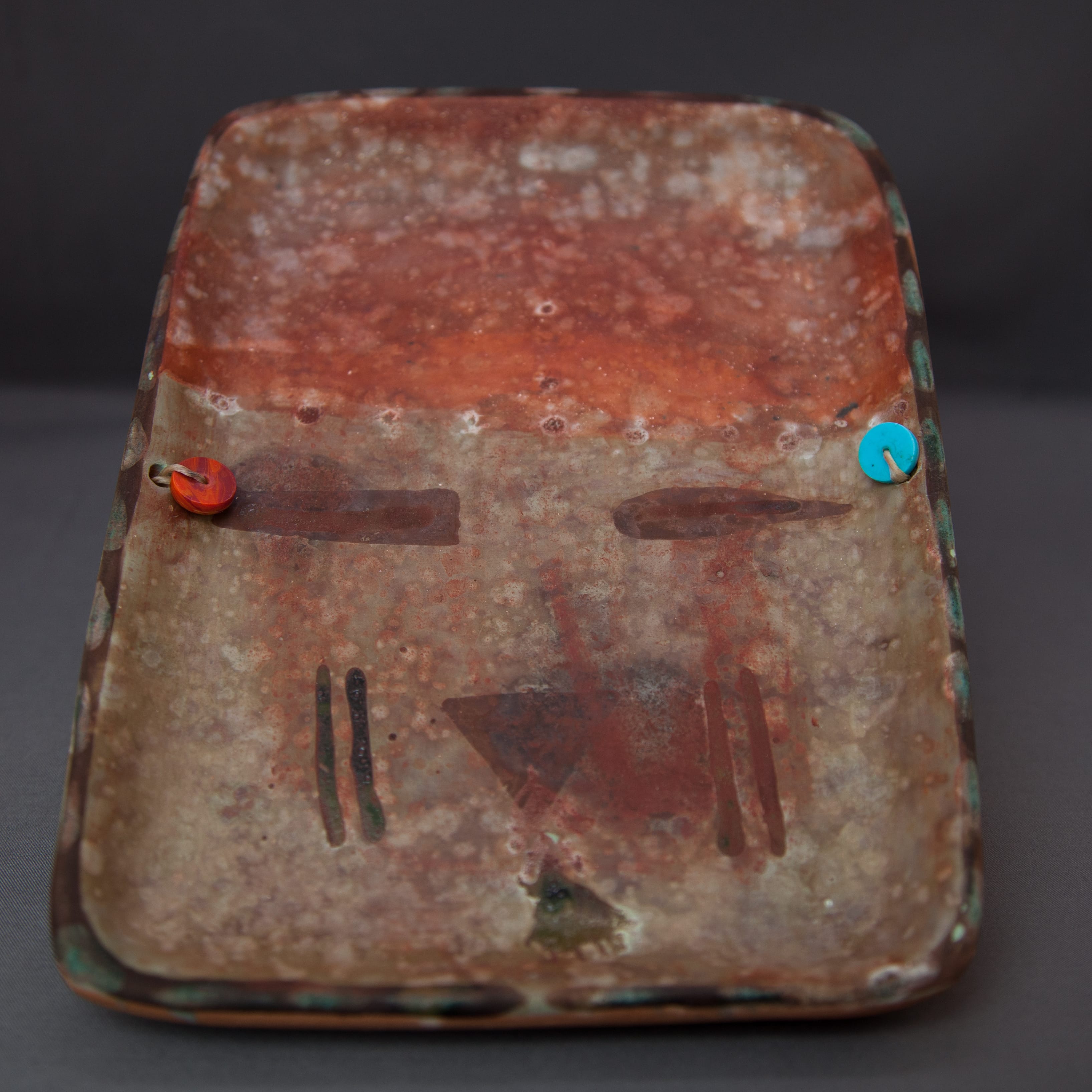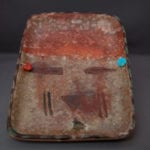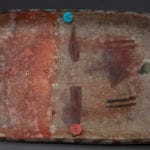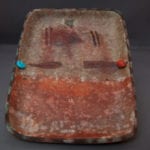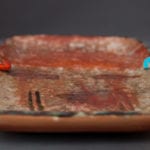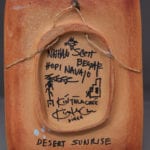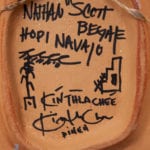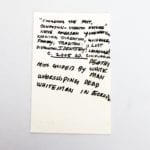This plaque is a simplified representation of Tawa, the Hopi sun god. Compared to other Begaye pots, the design is strikingly simple, though powerfully kind. It is easy to smile in response, as when I gaze at a statue of the Buddha. More poignant are Nathan’s inscription on the reverse and a note he wrote to accompany this plaque.
According to Harold Colton, Tawa is a deity and not a kachina spirit.
“The spirits of some of the deities appear as kachinas and are impersonated, but most of the deities are never impersonated or even represented by images. The Hopi recognize about thirty-six deities…
…(Tawa) the sun god travels the sky every day, ending his trip in the kiva of the Woman of the Hard Substances in the Pacisfic Ocean. He is considered to be a young, hansome god, gentle, kind and helpful. He never mingles with the people…His headdress is white soft eagle feathers and bronze parrot feathers. His face is painted with white corn meal, his body red and blue (Colton, 1959: 77, 80).”
Barton Wright provides an image of the Tawa kachina (1973:124).
Plaque 2017-07 was formed from a clay that fires pale pink. Flat tiles are made at Hopi, but this is the first Native plaque of that I have seen with a gentle rim, rounded corners and a raised oval foot. Holes are provided halfway down the length of the plaque for string that is used to affix red and blue disk earrings on the front. On the back this string is threaded through holes in the foot to facilitate hanging on a wall, as would be done with a cottonwood-carved representation of Tawa. Plaque 2017-07 appears to have been kiln fired.
The top 40% of the image is painted red, the bottom 60% a grey-green. Eight tiny raised dots of glaze separate the red forehead from the green face. From the midpoint of this line two additional dots rise into the forehead. Light drips of red glaze run down on the lower grey area. The painting of the face was done quickly, with large, broad strokes using a thick brush and a dark brown glaze. The left eye is rectangular and slightly wedge-shaped. The right eye is more curvilinear, like the cross-section of an airplane wing. These eye forms are also seen on Nathan’s canteen 2017-06, though there the painting is exceptionally delicate. A textured line of rough brown glaze forms the pupils in both eyes. The mouth is an isosceles triangle pointing down. A set of parallel lines are drawn on Tawa’s cheeks. These ” parallel marks are attributed to Pookanghoya, the Little War God” (Wright 1994:78). “ Below the triangular mouth is a rough, off-center somewhat triangular blotch of brown glaze. This mark is not expected on a Tawa face and might either be 1) a mistake, or 2) an intentional addition to throw the design off balance and energize it. We don’t know the reason, but given the superb craftsmanship of Nathan, I’d vote for intentional.
The entire surface of the glaze is mottled. At first it appears that the clay used to form the plaque was micaceous as tiny flecks of mica cover the rear of the plaque and are prominent in the red portion of the design. Such glitter, however, is not seen in the green face area of the design, suggesting that Nathan used a micaceous slip on only parts of 2017-07. In any case, being the Sun God and having a glittering presence seems entirely appropriate. The combination of mica glitter and the rough mottled surface attracts the eye and gives the plaque depth and character.
For a typical Hopi pot, I would end the description at this point. However, Nathan was not a typical potter and the inscription on the underside of this plaque –especially when combined with the note Nathan wrote to accompany the plaque—make this an untypical pot.
Inside the oval foot, Nathan provides a great deal of information. At the top is a small sketch of the Zia sun god that is at the center of the flag of New Mexico, except that here Nathan has filled in the face. Below is Nathan’s full name: “Nathan Scott Begaye,” Except on a painting done shortly before his death, I had never seen his middle name before, as his usual signature is either “Nathan B” or “Nathan Begaye.” The next two lines are typically part of his signature “Hopi Navajo” followed by a stylized rain cloud.
Just below the stylized cloud, corn flourishes in a pot because of the rain cloud above. To the right, a pueblo family makes their home. All is well. Below is printed the word “Kinthlachee” which I assume is Nathan’s Navajo clan name. Below that is an elegant script version of the same word. Finally there is the word “Dineh,” which is the name that Navajo people call themselves. Below the raised foot, Nathan has named this work “Desert Sunrise.” I understand these inscriptions say “Tawa returns to bless his people each day with sufficient moisture. Life continues. Life is good The sun shines on Nathan Scott Begaye of the kinthlachee clan.” Unusual for Nathan, the plaque is not dated.
I bought this plaque from Robert Nichols, who was Nathan’s dealer. Robert tells me that this is the only pottery by Nathan that he has seen with such an inscription on the bottom. Something unusual is going on here.
When Nathan sold this plaque to Robert Nichols in 2005, he wrote the following note to accompany the piece. Read from left to right, the note says:
“Forgetting the past,
Confusion –uncertn Future”
Native American youth not
Knowing direction, guideline,
Family Direction, guidance,
Distruction, IDENTITY! Language!
c. 2005 A.D. confusion
DEATH!
Miss Guided by White Man
Worshiping Dead
Whiteman in Europe
Notice from a photograph of this note on the website that the printed words also seem to arrange in vertical columns, particularly after the date 2005. This section of the note would then read:
Misguided by
Worshiping
Whiteman
confusion
DEATH!
White
Man
Dead
In Europe
I’m not sure the meaning much changes depending on the direction of the read. Nathan seems to be saying that:
“Native youth are confused about their future because they are not receiving guidance from traditional tribal and family values. Instead –in this year of 2005 A.D.—they are misguided by being seduced by white men to worship dead European values.”
There is great anger here.
At a minimum there is a stark contrast between the Tawa plaque and Nathan’s note. The plaque seems entirely positive, from the benign figure on the front to the sun, rain, corn and home images on the underside. By using his full name and clan designation, Nathan has firmly inserted himself into this blessing story. Perhaps the plaque is a prayer by Nathan to find some blessing space in his life.
In sharp contrast the note is a negative diatribe mourning the loss of Native tradition and bemoaning the substitution of degenerate white values. Given what I have been told about Nathan’s youth and subsequent struggles with tribal identity, substance abuse, and his own sexuality, I am making the assumption that much of the anger here is Nathan’s own, though framed as a concern for youth. (Nathan was about 47 when he made the plaque and wrote the note.) See the catalog entries for 2013-01 and 2015-02 for details of Nathan’s life. When asked about the note when I purchased this plaque, Robert simply said that Nathan was hurting and very angry during the last part of his life and made very little pottery. He was often very sick and lost a great deal of weight during this time and died five years after making plaque 2017-07.
Garth Clark was a major dealer of modern ceramics, represented Nathan, and curated a show in the Netherlands which became the basis of a book that included a discussion of Nathan’s art (2006: 20-37). On July 22, 2017 Garth gave a presentation at The Museum of Fine Art, Houston and I had a chance to ask him about Nathan:
“He (Nathan) was one of the top 5 or 6 potters that the movement produced.”
[When asked what he meant by “movement,” Garth replied]:
“Modernist potters. His best is unsurpassed.”
I am left with the impression of a brilliant man caught between great hope and great despair as he tried to cope with sickness and decline. I hope he has found some peace.

